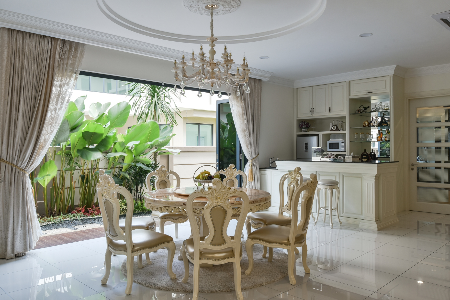As the dining space is arguably the most likely part of a home where family members can be expected to congregate, the selection of a dining table is probably the most important decision to be made - at least with regards to furnishings. We understand that the wide range of styles and materials available for dining tables may be overwhelming for most, so we put together this definitive guide to assist you in your search for the perfect dining table.
Material
The materials commonly used in dining tables greatly affect their longevity in terms of substance as well as style. Hardwoods, metals, tempered glass, stone, and even mould-injected plastics tend to be the materials of choice for long-term furnishings expected to endure years of physical impacts and spills. On the end of the scale would be the lightweight or flat-pack designs composed of veneered wood composites such as plywood and fibreboard. These engineered composites are significantly less durable, showing a tendency to warp when subjected to excessive moisture or heat. On the plus side, tables made of these materials are preferred for short-term and low-frequency applications as they tend to be easier to repack and move by design.
Natural materials such as hardwoods and stone tend to be porous, requiring regular maintenance and a coat of varnish or sealer to prevent permanent staining from everyday use - however artisans attest to some aesthetic benefits derived from a deliberate patina providing a personalized tinge to these natural materials.
 Natural materials such as hardwoods and stone tend to be porous, requiring regular maintenance and a coat of varnish or sealer to prevent permanent staining from everyday use. From iN Design Bumper Issue 2016. Image Credit: Latitude Design
Natural materials such as hardwoods and stone tend to be porous, requiring regular maintenance and a coat of varnish or sealer to prevent permanent staining from everyday use. From iN Design Bumper Issue 2016. Image Credit: Latitude Design
Metals would also need to be protected, albeit to a lesser degree by virtue of their inherent durability. Metal furnishings are at the highest risk of deterioration by rust when used outdoors, and especially when lacking a protective coating. To ensure the longest possible lifespan, a metal dining table should be powder-coated in carbon to provide protection against scratches.
Dining tables sporting tempered glass tops are much sought after as they provide a balance between eye-pleasing aesthetics and durability in their reflective surfaces. While glass is naturally lower in impact resistance when compared to metal, modern tempered glass is manufactured at such high pressures that its durability is virtually guaranteed in everyday circumstances.
 Dining tables sporting tempered glass tops are much sought after as they provide a balance between eye-pleasing aesthetics and durability in their reflective surfaces. From iN Design Bumper Issue 2016. Image Credit: The Roof Studio
Dining tables sporting tempered glass tops are much sought after as they provide a balance between eye-pleasing aesthetics and durability in their reflective surfaces. From iN Design Bumper Issue 2016. Image Credit: The Roof Studio
Mould-injected plastics are likely the most economical and durable solution for outdoor applications but as white plastics tend to turn yellow with age, care should be taken to minimize their exposure to direct sunlight.
Size
One of the most crucial considerations for your dining table would be its dimensions, as a dining table that is too large for its space forces diners to squeeze through narrow gaps between the wall and their seats. We recommend allowing for gaps between 90 centimetres to 1.3 meters (or 36 to 50 inches) of space between a dining table and the surrounding walls to enable diners to comfortably take their seats.
 We recommend allowing for gaps between 90 centimetres to 1.3 meters (or 36 to 50 inches) of space between a dining table and the surrounding walls to enable diners to comfortably take their seats. From iN Design issue #66. Image Credit: Design Base Interior
We recommend allowing for gaps between 90 centimetres to 1.3 meters (or 36 to 50 inches) of space between a dining table and the surrounding walls to enable diners to comfortably take their seats. From iN Design issue #66. Image Credit: Design Base Interior
Diners should be provided with ample elbow room to allow for a relaxing dining experience. Our recommendations are to provide each diner with around 60 to 70 centimetres (or 24 to 28 inches) of space. With this rule in mind, one can accurately determine the appropriate size for a dining surface needed to serve a particular number of diners.
Shape
The shape of a dining table should also be considered, as rectangular tables tend to accommodate fewer diners than round tables of a similar size. To calculate the number of diners appropriate for a round table: multiply the diameter of a table by the value of Pi (π: 3.14) and divide the result by the amount of space needed for each diner.
 Assuming a minimum of 60 centimetres (or 24 inches) of space needed per diner, a round table with a diameter of 1.5 meters can easily accommodate 7 diners. From iN Design Bumper Issue 2016. Image Credit: Turn Design Interior
Assuming a minimum of 60 centimetres (or 24 inches) of space needed per diner, a round table with a diameter of 1.5 meters can easily accommodate 7 diners. From iN Design Bumper Issue 2016. Image Credit: Turn Design Interior
Assuming a minimum of 60 centimetres (or 24 inches) of space needed per diner, a round table with a diameter of 1.5 meters can easily accommodate 7 diners, or up to 8 diners with a negligible reduction in elbow room. A rectangular table that is 1.5 meters long can only seat a total of 6 diners - one at each end and two along each length.
 A rectangular table that is 1.5 meters long can only seat a total of 6 diners – one at each end and two along each length. From iN Design issue #71. Image Credit: Pocket Square
A rectangular table that is 1.5 meters long can only seat a total of 6 diners – one at each end and two along each length. From iN Design issue #71. Image Credit: Pocket Square
The choice of a dining table's shape has a noticeable effect on the space it occupies. Round tables, while capable of accommodating a greater number of diners, tend to appear imposing in tight quarters and are generally not suitable for small dining spaces as a result. Conversely, the more conventional rectangular dining tables take up the most space, requiring long and narrow spaces to avoid appearing out of proportion.
 Round tables, while capable of accommodating a greater number of diners, tend to appear imposing in tight quarters. From iN Design Bumper Issue 2015. Image Credit: D'concepto Design
Round tables, while capable of accommodating a greater number of diners, tend to appear imposing in tight quarters. From iN Design Bumper Issue 2015. Image Credit: D'concepto Design
 Rectangular dining tables take up the most space, requiring long and narrow spaces to avoid appearing out of proportion. From iN Design issue #78. Image Credit: Living Space Creative Design
Rectangular dining tables take up the most space, requiring long and narrow spaces to avoid appearing out of proportion. From iN Design issue #78. Image Credit: Living Space Creative Design
Height
Dining tables are commonly manufactured within a standard range of heights, from 710 to 760 centimetres (or between 28 to 30 inches), which makes finding them a relatively easy task. The key considerations to apply when looking at the various heights of dining tables is that the surface should be sufficiently low to provide an ergonomic resting place for arms, while the support structures beneath the surface should be sufficiently high to prevent knocking against knees.
To conserve floor space for smaller dining areas, open layout concepts, or simply for variation - consider counter-height tables, measuring up to 910 centimetres (or 36 inches) in height to join with kitchen counters, or bar-style tables around one meter in height.
 Consider counter-height tables, measuring up to 910 centimetres (or 36 inches) in height to join with kitchen counters. From iN Design magazine issue #74. Image Credit: Nu Infinity
Consider counter-height tables, measuring up to 910 centimetres (or 36 inches) in height to join with kitchen counters. From iN Design magazine issue #74. Image Credit: Nu Infinity







Leave your comment